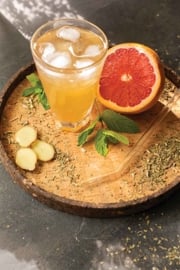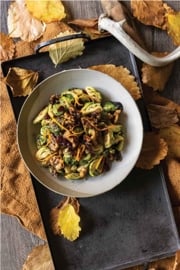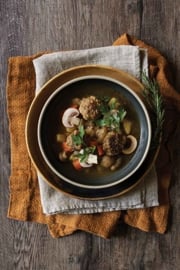
This elegant grilled asparagus salad with jammy eggs, blistered onions, chewy spelt, and an attention-grabbing creamy dressing is the perfect way to celebrate the spring sunshine. Spelt berries are sold with their hulls intact, which means they’ll take a bit longer to cook but will reward your patience with al dente chewy nuttiness. They can be swapped out for rye berries, wheat berries, or gluten-free sorghum.
Asparagus Egg Salad with Tahini Miso Dressing
Ingredients
- 3/4 cup (180 mL) spelt berries
- 4 large organic eggs
- 1 large bunch asparagus, woody ends trimmed
- 2 tsp (10 mL) grapeseed or sunflower oil, divided
- 8 green onions, root ends trimmed
- 2 Tbsp (30 mL) tahini
- 2 Tbsp (30 mL) white or yellow miso
- Juice of 1/2 lemon
- 1 tsp (5 mL) honey
- 1 garlic clove, minced
- 1/3 cup (80 mL) sliced unsalted roasted almonds
- 2 Tbsp (30 mL) capers
Nutrition
Per serving:
- calories344
- protein18g
- fat16g
- saturated fat3g
- trans fat0g
- carbohydrates38g
- sugars7g
- fibre9g
- sodium433mg
Directions
01
In medium-sized saucepan, place spelt, 2 1/2 cups (625 mL) water, and generous pinch of salt. Bring to a boil, reduce heat to maintain a strong simmer, and cook, covered, until spelt is tender, about 40 minutes. Drain well.
Bring medium saucepan of water to a boil over medium-high heat. Using slotted spoon, carefully lower eggs into water one at a time. Cook for 6 1/2 minutes, adjusting heat to maintain a gentle boil. Transfer eggs to bowl of ice water and chill for 2 minutes. Gently
crack eggs all over and peel, starting from the wider end with the air pocket. Gently slice eggs in half; yolks will be runny.
Build a medium-hot fire in charcoal grill, or heat gas grill to medium-high and grease grill grates.
Toss asparagus with 1 tsp (5 mL) oil. Place on grill grate and heat until tender and charred in a few spots, turning once, 3 to 4 minutes. If stalks are large, they might take longer to cook. Generally, asparagus is ready when you can easily pierce the middle with a fork.
Brush green onions with remaining 1 tsp (5 mL) oil. Place on grill grate and cook, turning once, until grill marks appear and they are fork-tender all the way through, about 8 minutes. Remove from grill.
In bowl, whisk together tahini, miso, lemon juice, honey, and garlic. Whisk in warm water, 1 Tbsp (15 mL) at a time, until a thin consistency is reached.
To assemble salad, divide asparagus and green onions among 4 serving plates. Top with spelt, eggs, almonds, and capers. Drizzle Tahini Miso Dressing overtop.
Tip: Soaking whole grains, such as spelt, for several hours in cold water can slash their cooking time by about 25 percent.





